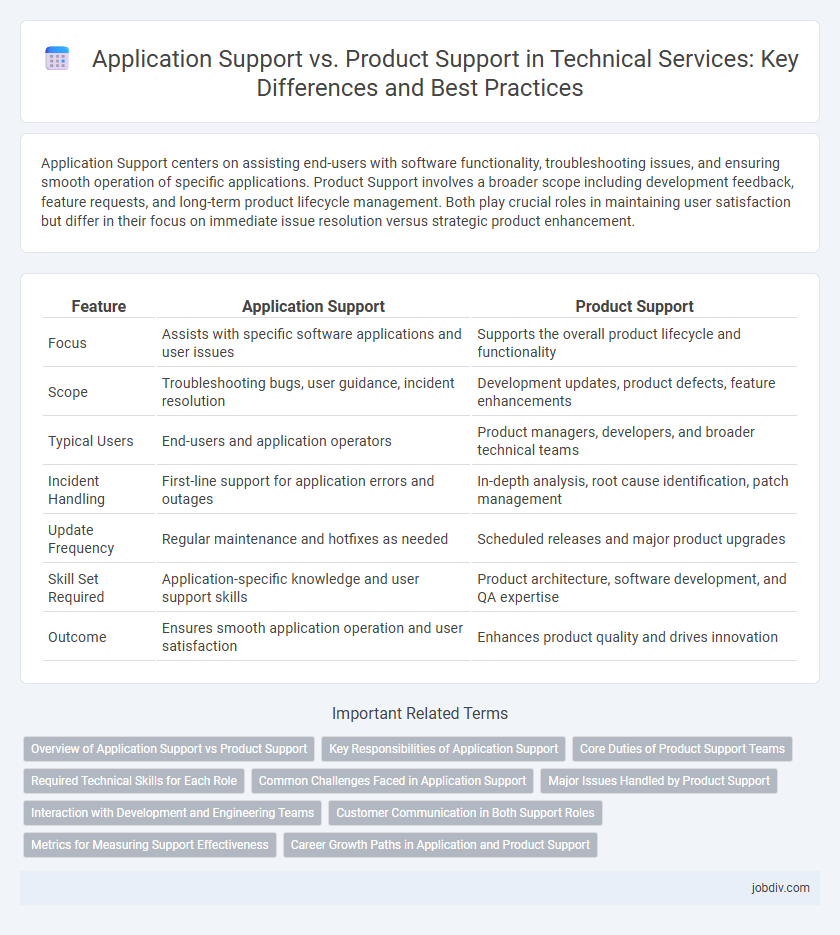Application Support centers on assisting end-users with software functionality, troubleshooting issues, and ensuring smooth operation of specific applications. Product Support involves a broader scope including development feedback, feature requests, and long-term product lifecycle management. Both play crucial roles in maintaining user satisfaction but differ in their focus on immediate issue resolution versus strategic product enhancement.
Table of Comparison
| Feature | Application Support | Product Support |
|---|---|---|
| Focus | Assists with specific software applications and user issues | Supports the overall product lifecycle and functionality |
| Scope | Troubleshooting bugs, user guidance, incident resolution | Development updates, product defects, feature enhancements |
| Typical Users | End-users and application operators | Product managers, developers, and broader technical teams |
| Incident Handling | First-line support for application errors and outages | In-depth analysis, root cause identification, patch management |
| Update Frequency | Regular maintenance and hotfixes as needed | Scheduled releases and major product upgrades |
| Skill Set Required | Application-specific knowledge and user support skills | Product architecture, software development, and QA expertise |
| Outcome | Ensures smooth application operation and user satisfaction | Enhances product quality and drives innovation |
Overview of Application Support vs Product Support
Application Support primarily involves maintaining, troubleshooting, and enhancing software applications to ensure seamless functionality and user satisfaction. Product Support focuses on comprehensive assistance related to a product's lifecycle, including hardware, software, and user guidance to resolve issues and improve user experience. Both support types aim to optimize performance, but Application Support is more technical and software-centric, while Product Support encompasses a broader range of customer service aspects.
Key Responsibilities of Application Support
Application Support primarily focuses on maintaining and troubleshooting software applications to ensure optimal performance and minimal downtime. Key responsibilities include incident management, root cause analysis, user support, and coordinating with development teams for bug fixes and enhancements. Monitoring application health, managing updates, and providing detailed documentation are essential to sustaining seamless functionality in dynamic IT environments.
Core Duties of Product Support Teams
Product support teams primarily focus on managing the lifecycle of a software product, including troubleshooting, bug fixing, and providing user assistance to ensure product stability and performance. Their core duties involve coordinating updates, handling feature requests, and maintaining comprehensive knowledge bases to enhance user satisfaction. Emphasis on proactive issue resolution and continuous product improvement distinguishes product support from application support, which typically centers on operational aspects of deployed software.
Required Technical Skills for Each Role
Application Support professionals must possess strong skills in troubleshooting software issues, understanding application lifecycles, and proficiency with database management and scripting languages such as SQL and Python. Product Support experts require in-depth knowledge of product architecture, configuration management, and hands-on experience with customer-facing technologies, often involving API integrations and version control systems like Git. Both roles benefit from expertise in monitoring tools and incident management systems, but Application Support leans more towards operational problem-solving while Product Support demands a strategic grasp of product development and deployment processes.
Common Challenges Faced in Application Support
Application Support teams frequently encounter challenges such as incident management complexities, handling escalations effectively, and maintaining seamless communication between development and operations. They must troubleshoot software bugs, manage version control issues, and ensure minimal downtime, all while supporting diverse user environments. Coordinating timely updates and managing user expectations also remain critical obstacles in delivering consistent application performance.
Major Issues Handled by Product Support
Product Support primarily addresses major issues such as critical software defects, system outages, and performance bottlenecks that impact end-user experience and business continuity. This team focuses on resolving bugs, deploying patches, and managing escalations from Application Support to ensure product stability and compliance with service-level agreements (SLAs). Product Support also handles compatibility problems, security vulnerabilities, and feature malfunctions that require in-depth technical expertise and collaboration with development teams.
Interaction with Development and Engineering Teams
Application support teams collaborate closely with development and engineering teams to resolve software issues, deploy updates, and ensure seamless functionality tailored to specific client environments. Product support focuses on broader product-related inquiries, feature requests, and long-term improvements by providing critical feedback to engineering during product lifecycle management. Clear communication channels between support and engineering enhance issue resolution speed and drive continuous product innovation.
Customer Communication in Both Support Roles
Effective customer communication in application support involves promptly addressing user issues related to software functionality and providing clear troubleshooting guidance to minimize downtime. Product support communication centers on gathering user feedback and delivering updates about product features, enhancements, and bug fixes to ensure customer satisfaction and product improvement. Both roles require empathetic listening and precise information transfer to maintain strong client relationships and resolve concerns efficiently.
Metrics for Measuring Support Effectiveness
Application Support effectiveness is often measured by metrics such as incident resolution time, first contact resolution rate, and system uptime, ensuring minimal disruption and rapid problem-solving for users. Product Support focuses on customer satisfaction scores, defect resolution rates, and feature request turnaround time to enhance user experience and product quality. Monitoring these distinct metrics allows organizations to tailor support strategies, improve service delivery, and align support outcomes with business objectives.
Career Growth Paths in Application and Product Support
Career growth in Application Support often involves progressing from technical troubleshooting roles to senior support engineer positions, with opportunities to specialize in system administration, software development, or client management. Product Support careers emphasize deep product expertise, evolving towards roles such as product manager, customer success manager, or technical consultant, leveraging intimate knowledge of product features and user needs. Both paths offer advancement through certifications and experience, but Application Support tends to focus more on IT infrastructure and operational skills, while Product Support centers on product lifecycle and customer experience management.
Application Support vs Product Support Infographic

 jobdiv.com
jobdiv.com